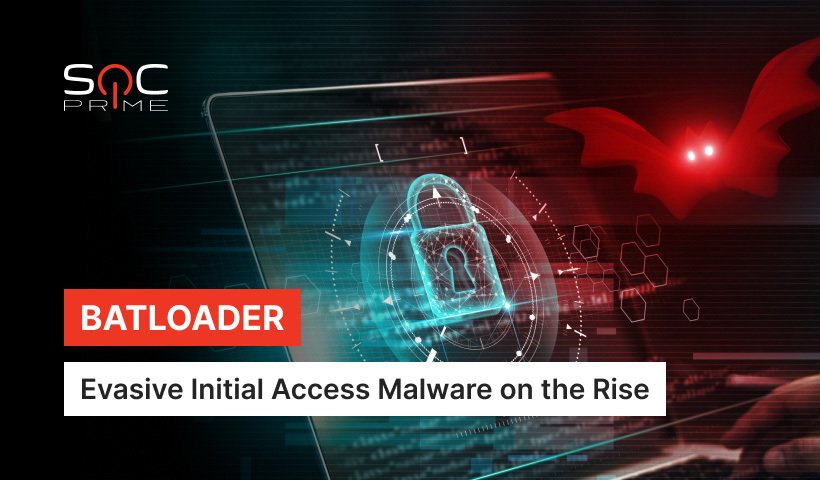BatLoader Malware Detection: Evasive Downloader on the Rise

Table of contents:
Security experts warn of the notorious stealthy malware dubbed BatLoader, which has been increasingly infecting instances worldwide over the last few months. The notorious threat acts as a malware downloader dropping a variety of malicious payloads on the victims’ systems. During the latest campaigns, BatLoader has been observed delivering banking Trojans, ransomware samples, information stealers, and the Cobalt Strike post-exploitation toolkit.
Notably, BatLoader obtains a set of detection evasion features allowing the threat to fly under the radar. It relies heavily on batch and PowerShell scripts to prevent cybersecurity practitioners from detecting and blocking malicious campaigns. The sophisticated attack routine shares several similarities with Conti ransomware and Zloader banking Trojan.
Detect BatLoader Malware Execution
With BatLoader malware operators constantly adding new evasive tricks to their offensive capabilities, cyber defenders are looking for new ways to timely identify infection in the organization’s infrastructure. SOC Prime’s world’s largest and most advanced platform for collective cyber defense curates brand-new Sigma rules to detect BatLoader. Both detections crafted by our keen Threat Bounty developers, Osman Demir and Sittikorn Sangrattanapitak, are mapped to the MITRE ATT&CK® framework and are compatible with industry-leading SIEM, EDR, BDP, and XDR solutions. Follow the links below to instantly gain access to relevant Sigma rules and dive into their cyber threat context:
Suspicious BatLoader Malware Execution by Use of Powershell (via cmdline)
This Sigma rule developed by Osman Demir detects the BatLoader malware execution via a malicious Powershell command. The detection addresses the Execution tactic with the corresponding Command and Scripting Interpreter (T1059) technique.
Possible Batloader Malware Execution by Gpg4Win Tool (via process creation)
The above-mentioned piece of content crafted by Sittikorn Sangrattanapitak detects the deployment of Gpg4win to decrypt malicious payloads via the BatLoader malware. This Sigma rule addresses the Execution tactic with the User Execution (T1204) and Command and Scripting Interpreter (T1059) used as its primary techniques.
Both aspiring and hard-battled Threat Hunters and Detection Engineers eager to hone their Sigma and ATT&CK skills and help others defend against emerging threats can tap into the SOC Prime Threat Bounty Program. By joining this crowdsourcing initiative, cybersecurity experts can write their own Sigma rules mapped to ATT&CK, share them with the global cyber defender community, and receive recurring payouts for contributions.
To instantly reach Sigma rules for BatLoader detection, just click the Explore Detections button. Drill down the comprehensive cyber threat context, including MITRE ATT&CK references, threat intelligence, executable binaries, and mitigations for streamlined threat research.
BatLoader Analysis
Initially revealed and analyzed by Mandiant in February 2022, BatLoader keeps evolving, which poses a significant menace for cybersecurity practitioners.
The latest inquiry by VMware Carbon Black reveals that BatLoader malware leverages a number of sophisticated features to stealthily infect unsuspecting victims and drop second-stage payloads on their machines. Among the latest BatLoader victims are organizations in business services, finance, manufacturing, education, retail, IT, and healthcare sectors.
Mainly, BatLoader operators rely on search engine optimization (SEO) poisoning to redirect victims to fake websites and push them to download the malware. For instance, in one of the latest BatLoader campaigns victims were lured to visit fake downloading pages for popular software, such as LogMeIn, Zoom, TeamViewer, and AnyDesk. Malware operators pushed links to those malicious web pages via fake ads actively shown in search engine results. Using living-off-the-land binaries makes detection and blocking the campaign a challenging task, especially at the earliest stages of the attack development.
Following the infection, BatLoader relies on batch and PowerShell scripts to gain an initial foothold in the victim’s network. Notably, BatLoader has a built-in logic allowing the malware to identify if the targeted machine is either corporate or personal and drop corresponding second-stage payloads in each case. For corporate environments, BatLoader usually applies intrusion tools, such as Cobalt Strike and the Syncro remote monitoring and management utility, while if the malware lands on a personal computer, it proceeds with information stealing and banking Trojan payloads.
Notably, BatLoader campaigns are observed to share some similarities with other infamous malicious samples, including Conti ransomware and the Zloader banking Trojan. The overlaps with Conti include leveraging the same IP addresses as Conti applied for its Log4j campaigns and the use of a remote management tool Atera. And with Zloader, the malware shares the same infection tricks, mainly, the use of SEO poisoning techniques, PowerShell & batch scripts, and other native OS binaries.
Stay ahead of attackers and proactively detect notorious threats with curated Sigma rules in the SOC Prime Platform. Detections for current and emerging threats are at hand! Explore more at https://socprime.com/.



